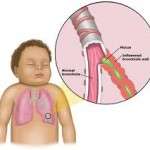What is Bronchiolitis in Babies?
 Bronchiolitis is a viral infection which affects the lower respiratory tract. This is common in babies below the age of two. The viral attack causes inflammation in the tiny wind tract of the kids, resulting in blockage of the airway. The partial blockage results in a whistling sound emerging with the breath, resulting in lesser supply of oxygen to the lungs. This is a common illness found in the children and infants and is a cause for hospitalization in many severe cases.
Bronchiolitis is a viral infection which affects the lower respiratory tract. This is common in babies below the age of two. The viral attack causes inflammation in the tiny wind tract of the kids, resulting in blockage of the airway. The partial blockage results in a whistling sound emerging with the breath, resulting in lesser supply of oxygen to the lungs. This is a common illness found in the children and infants and is a cause for hospitalization in many severe cases.
Treatment involves measures to ensure that the child breathes without difficulty and is adequately fed with sufficient fluid intake. This state continues for about a week from the time the symptoms are first noticed, but in extreme cases this may take even two weeks to cure fully. The parents should remember that extreme infection can have serious consequences and care should be taken from the appearance of the first symptoms.
This being a viral infection has association with the weather conditions. In the Northern hemisphere this breaks out during the months of November to April and in the Southern hemisphere, from May to September. The peak time is during rainy season when the weather is wet and cold. A child may get infected even more than one time in a season but the subsequent infection is milder than the first one. Children above the age of two develop RSV which has symptoms resembling bronchiolitis with milder wheezing.
The common symptoms of bronchiolitis in babies are:
- Nasal congestion associated with discharge
- Cough
- Fever above 100°F
- Decreased appetite
- Rapid breathing with wheezing sound which lasts for seven days
As a result of the breathing difficulties, the child finds it difficult to eat or drink and it may result in dehydration. The first sign of bronchiolitis are pause in breathing for about 20 seconds, sucking in of skin around ribs and base of throat, nasal flaring and grunting. The low supply of oxygen causes the skin to turn blue. The child gets tired easily and at occasions stops breathing. This stage requires immediate medical attention.
This is a contagious disease and is transmitted through droplets containing viral infection. These enter the atmosphere by coughing or sneezing of the infected child or may be carried by the hands of the person taking care of the child. Due to this reason the infected child should be kept away from the healthy children. Bronchiolitis can be easily detected by a medical specialist by examining the chest of the patient with a stethoscope.
Bronchiolitis Treatment in Infants
In severe cases where the toddler stops breathing occasionally or the skin starts to turn blue, immediate hospitalisation may be required and no time should be wasted shifting the child to the emergency section of the hospital.
If the child is at home and the intensity is not severe, regular monitoring should be done to ensure that the condition does not worsen and the child is taking sufficient liquid and diet. Fever causes lot of discomfort to the child and medicine to reduce the fever needs to be given orally. If the child is unable to retain this medicine it may be injected. To ease nasal congestion saline nose drops can be put in the nostrils. To reduce the viral infection the patient is given antibiotics and cough syrups, though cough results in clearing of the lungs. Keeping the head of the child elevated may ease breathing difficulty.
Improvement begins within 3 to 4 days of start of treatment but wheezing may persist for a week or still longer. Treatment needs to be continued. The child should not be sent to school or day care centre till fully recovered and the fever is normal for at least two days.
Preventive measures that will help the child not to develop this problem are:
- Keep the child away from the infected child.
- Avoid smoking in the room occupied by children. Smoking results in respiratory illness.
- Use antibacterial soap before touching the child and wash hands frequently especially during cold and wet months.
- If the adult in household has cough and cold he should avoid coming close to the child.
- Vaccination against influenza viruses should be got administered as recommended by health specialists.
- Keep the child in a well ventilated room and in case of high fever do not over wrap the child.
- Avoid steaming or hot water humidification, this can be hazardous.
- Be regular in giving medicine and change clothes regularly. Wash the clothes using disinfectant.